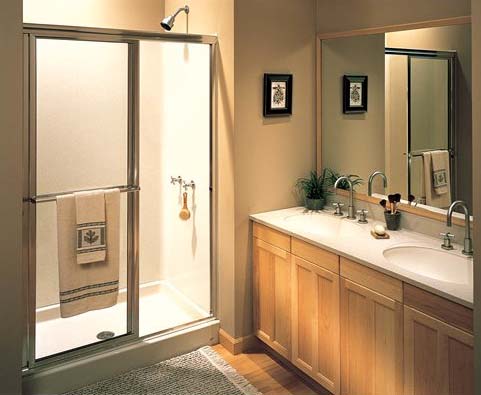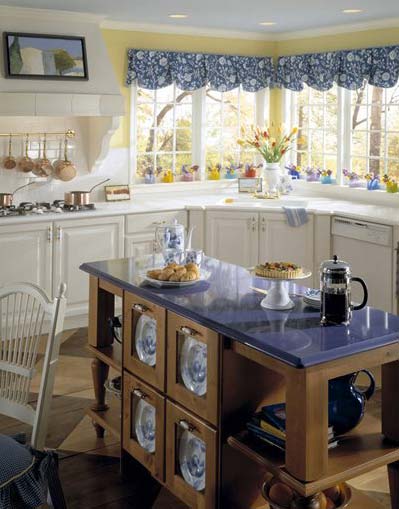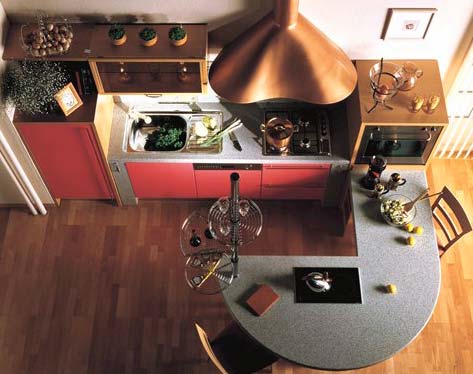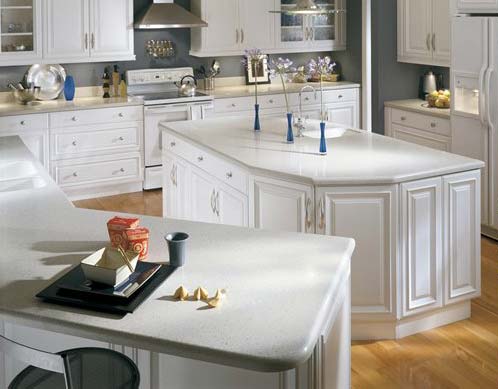More Than 35 Years Of Dedicated Service Across Western & Central NY
Frequently Asked Questions
Is this your first experience buying or designing countertops for your home? Let us walk you through the process and explain why Solid Surfaces NY is the best choice for custom countertops in the Rochester area.
Planning FAQ’S
Q. What do I need to have ready before templating the countertop area?
There are several things you can do to prepare for digital templating:
1. All cabinets must be permanently fixed in place.
2. Remove everything from the countertop space.
3. Have all sinks on-site.
4. Have all faucets and any other fixtures to be used on-site.
5. Have all cooking appliances on-site, including downdraft if applicable (preferably NOT in place).
6. Have any grommets on-site (e.g. a grommet would be used to finish holes cut for wires and cables in computer desks).
Q: How long does it take before my countertop is installed?
Our goal is to process and schedule your countertop for fabrication and installation as quickly as possible. Turn around times may vary from project to project and can be better determined once we have evaluated your specific needs.
Q. Will you be taking the sink, faucet, cooktop, or downdraft?
Sometimes we need to take fixtures back to the shop to verify proper fit at the time of manufacture. The measuring technician will make this determination at the time of measure.
Q. How do I choose the right sink?
The most important thing to consider when selecting a new sink is whether or not it will fit the sink cabinet. Many sink manufacturers will indicate the recommended minimum cabinet size for their sinks. Below are some general guidelines for selecting a sink, however, fit and placement will be confirmed by the Solid Surface NY Team after your countertop area has been measured.
– Undermount sink: The entire sink must be able to fit inside the cabinet, including the flange that runs around the outside edge. Some oversized sinks require deeper than normal cabinets to allow room for the faucet and fixtures.
– Drop-in sink: The bowl(s) must fit inside the cabinet (left to right); the finished flange will sit on top of the countertop.
– Vessel: Typical installation requires vessel sinks to fit the area of the countertop. However, since vessels are often custom fit it is recommended that you consult a designer or representative of The Top Shop to verify fit.
– Apron: Apron sinks must fit inside the cabinet (left to right). All apron sinks MUST be installed prior to digital templating.
Q: Who will mount the sink?
The Solid Surfaces NY Installers will look after mounting and sealing undermount sinks only on-site. Cast iron undermount sinks will be initially mounted by The Solid Surfaces NY Installers, however, we recommend additional support be built to reinforce the installation. Mounting of Apron sinks are the responsibility of the client and must be completed prior to digital templating.
Q: How is the sink mounted?
Epoxy resins, silicone, and/or under mounting brackets may be used. Some projects require different methods or additional substructures.
Q: Who hooks up the faucets and sink drains?
The hookup of all drains, faucets, sink fixtures, cooking appliances, garborators, grommets, etc. are the responsibility of the client. The Solid Surfaces NY Installers will dry-fit items such as faucets and cooking appliances to ensure proper fit. For an additional fee, Solid Surfaces NY will also tear out old countertops and hook up the drains and faucets in the new countertop. Ask our showroom for details!
Q: Do garborators need extra support?
Yes. To reduce the cumulative effects of weight and torque vibrations, garborators should be supported in such a way that the hanging weight is minimized. One way to properly support the garborator is to insert a block of wood that is one eighth of an inch larger than the space between the bottom of the installed garborator and the floor of the base cabinet.
Q: When can I hook up the sinks and faucets?
You should wait 24 hours for the silicone to cure. Feel free to hook up drains and faucets 24 hours after the installation has been completed.
Q: Who will install my countertop?
Installation is performed by Solid Surfaces Installers to ensure finishing touches are expertly applied. Solid Surfaces Installers are trained professional stone countertop installers who are able to look after the fine details of installation.
Q: Will Solid Surfaces NY do cabinet or trim work?
Solid Surfaces NY does not perform cabinet and/or trim work
Q: How does the dishwasher attach to the countertop?
A Solid Surfaces Installer will epoxy a 1/2” piece of wood where your dishwasher needs to attach to the counter. You will then be able to use 3/8” screws to mount the dishwasher. This keeps the dishwasher from tipping forward.
Many newer model dishwashers have side mount capability which eliminates the need for a piece of wood (as described above) and leaves you with a clean look.
Q: How do I know if my cabinets are strong enough to hold stone?
Most cabinets are more than capable of supporting the weight of stone countertops. The measuring technician will gladly discuss support requirements while visiting your home.
Design FAQ’S
Q: How much support do I need for free overhang areas?
Generally, you are allowed up to ten inches of overhang without support. Individual brackets should be positioned with no more than 24 inches between supports. As support requirements may vary from project to project, some exceptions may apply. Please consult your designer for details on your specific situation.
Q: Do I need joints/seams and will they be noticeable?
The location of countertop and/or backsplash joints is dependent on various factors including slab size, material type, access into job site, and job lay-out. The epoxy used to glue joints together is similar to the colour of your countertop; however, seams are still noticeable by touch and sight.
Q: Can certain areas on my slab be included/excluded?
While selecting the material, you may fall in love with a particular feature of the stone on your slab. Feel free to mention this to the salesperson at selection time and they will map the stone to include/exclude the desired area. Although every effort will be made to include/exclude the noted area, it may be necessary to cut contrary to your wishes depending on a number of factors that are determined after you have selected your material and the order has been processed.
Q: How much overhang should I have? (doors, panels, eating bars, high bars)
As Solid Surfaces NY is a completely custom countertop fabrication factory, norms and set standards for overhangs are flexible and decided on a case-by-case basis. It has been our experience, however, that our clients will often decide on overhangs that fall into the following ranges:
– Doors: 1 ½” to 2” overhang from base cabinet
– False Doors: 1 ½” to 2” overhang from base cabinet
– Flat Panels: 1” to 1 ½” overhang from base cabinet
– Peninsula Eating Bars: 8” to 12” overhang from base cabinet
– Island Eating Bars: 8” to 12” overhang from base cabinet
– High Bars: 8” to 12” overhang from base cabinet (min. finished width 15”)
Please note, the above information is useful as a planning guide only. We recommend following the advice of a designer or a staff member of Solid Surfaces as they will be able to evaluate your specific design requirements.
Q: What is the difference between a drop-in and an undermount sink?
A drop-in sink is self-rimming and is typically used with laminate countertops. Undermount sinks are rimmed by the polished stone countertop and are mounted to the bottom of the countertop.
Q: Can I add matching pieces in the future?
Whether you choose granite or quartz, we strongly recommend completing each room in your home as part of the same project. There is no guarantee that future pieces will match in colour, texture, or shading.
Q: Will the corners be sharp or round?
All outside corners are rounded. The minimum radius that can be applied to an outside 90 degree corner varies depending on the edge profile. Larger radii are available depending on the overhang from the base cabinet. The minimum radius that can be applied to an inside 90 degree corner is 68mm because of the tools we use.
Q: Is there an extra charge for the edge profile?
Of the ten edge profiles available for you to choose from, only the chiseled and ice edges cost more. Sample edge profiles are available in our showroom.
Q: How thick is the backsplash?
Backsplashes are typically 1 ¼”.
Q: Do I need a backsplash?
No, backsplashes are optional with stone countertops. Although design requirements will vary from project to project, many contemporary designers exclude traditional 3 ½” to 4” splashes in favour of painted drywall or tile.
Q: I’m renovating and I have an existing tile backsplash as well as a 3 ½” laminate backsplash. What will I do with the space between my countertop and tile when I replace my laminate top with a stone countertop?
There are several options available to you:
– Remove all existing tile and install new tile
– Install runner or accent tile (matching or new)
– Remove all existing tile, finish, and paint the wall
– Install a matching stone backsplash between the countertop and tile
Site Preparation FAQ’S
Q: Who measures the countertop space?
A: Solid Surfaces NY will arrange for a trained countertop measure technician to visit your home to complete a digital template.
Q: Is it okay to watch the progress of the installation?
Once our installers begin installation of your countertop, the area becomes a work site and safety becomes a concern; not just for the workers but for all the people in your home. You are welcome to view the progress from time to time but for safety reasons we ask you to give the installers enough room to complete their work without interruption. This often means leaving the room in which the installation is occurring.
Q: I am doing my own tear out, what do I have to do to get ready for the installation?
The existing laminate top must be removed, and cabinets leveled. Sinks, faucets, garburators, etc.
must be uninstalled and all plumbing disconnected. Gas lines and hard-wired cooking appliances must be disconnected and moved out of the way. Additional prep work may be required and will be assessed by Solid Surfaces NY.
Q: What do I need to have ready before you template the countertop area?
There are several things you can do to prepare for digital templating:
1. All cabinets must be permanently fixed in place.
2. Remove everything from your countertop space.
3. Have all sinks on-site.
4. Have all faucets and any other fixtures to be used on-site.
5. Have all cooking appliances on-site, including downdraft if applicable (preferably NOT in place).
6. Have any grommets on-site (ex. a grommet would be used to finish holes cut for wires and cables in computer desks).
Q: Do I have to remove the existing countertop before you come to measure?
We can measure with existing countertops in place; however, accuracy and fit is optimal with the existing tops removed. Additionally, all appliances and personal effects must be removed from the countertops before we can measure.
Q: What exactly do The Solid Surfaces Installers do/not do?
Installers will:
– Be courteous and treat your property with respect
– Affix all stone countertops to your cabinetry
– Perform seam work as required
– Mount and secure undermount sinks
– Clean up after themselves
Installers will not:
– Perform finish work on trim or cabinetry
– Hook up plumbing, electrical, or gas
– Remove upper cabinets and appliance garages.
*Tear-out and plumbing packages are available, please ask our staff for details!
Q: Do I have to be present at the time of installation?
Yes. We require the decision maker to be present for the entire installation.
Q: What if I am not satisfied with the installation of my new countertop?
Please discuss any issues you may have with the Installers at the time of installation. Often minor
issues can be resolved on the spot. However, if you feel any issues have not been resolved to your
satisfaction, please contact us immediately.
Use and care:
How to maintain your countertops
Q: Do I have to seal my granite countertop as soon as I receive it?
No, we seal all granite tops during fabrication.
Q: How long will the sealer last?
The sealer applied is rated for 15 years. However, absorbency may vary from stone to stone. If water is absorbed and does not bead up it is time to apply another coat of sealer.
Q: How will I know when my natural stone countertop needs to be re-sealed?
You can do a basic test by splashing some water on the surface. If the water beads, you do not have to re-seal the countertop. If the water absorbs into the stone after five minutes, you will need to re-seal the countertop.
Q: Can I seal the natural stone countertop myself or will I have to hire a professional?
A: Sealing is a simple at home procedure, there is no need to hire a professional. However, we will gladly visit your home to seal the countertops if you prefer (travel and labor rates will apply).
Q: How do I seal my natural stone countertops and where can I purchase sealer?
The process varies depending on the manufacturer, follow directions accordingly. Most sealers require that you cover the surface and wait for a short period of time before wiping it down. Sealer is available for purchases at Solid Surfaces NY.
Q: Do I have to seal quartz countertops?
A: Sealing quartz is not necessary because of the way it is manufactured. We recommend reading the ‘Use and Care’ guidelines for your product for further information.
Q: How do I care for stone countertops?
Both granite and quartz require minimal care to maintain their natural beauty. For more information, please click on the links below:
Q: What if I leave red wine spilled on my countertop overnight?
Any spills should be promptly cleaned off the countertop to prevent staining. Red wine left overnight on a countertop may leave a stain.
Q: If I get a stain, can it be removed?
Some stains can be removed but each situation needs to be evaluated on a case-by-case basis. If you have a concern about staining, please feel free to contact us for advice.
Q: Will granite or quartz scratch?
Both granite and quartz are among the hardest materials on earth and are very resistant to scratching. Diamonds, unfinished stone, coarse ceramics, etc., should be kept off the surface of your countertops.
Q: Can I cut on my stone countertops?
Cutting on granite and quartz countertops will dull knife blades prematurely. Although it is unlikely you will scratch countertop with a knife, we recommend using a cutting board to preserve both knife edges and countertop surfaces.
Q: Can I set a hot pot on my countertop?
A: Stone countertops are very resistant to heat, but they are not heat proof. Some slabs have resins along the surface which could scorch or burn if a hot pot is placed on the countertop; therefore, it is recommended that you always use a trivet or heat pad.
Characteristics of granite and quartz: General information about stone countertops
Characteristics of Granite and Quartz:
General information about stone countertops
Q: What are those tiny hairline cracks on the surface of my granite?
Granite, which is crystalline in structure, sometimes has natural fissures which may look like cracks, but are not structural defects and are a naturally occurring result of the immense heat and pressure that formed the granite eons ago. These characteristics are part of the natural beauty of stone and will not impair the function or durability of the material. A product of nature cannot be expected to look manmade.
Q: Why does my granite countertop have tiny holes?
Granite, which is crystalline in structure, always has tiny pits – spaces between the various mineral crystals. These pits are not structural defects and are a naturally occurring result of the immense heat and pressure that formed the granite eons ago. These characteristics are part of the natural beauty of stone and will not impair the function or durability of the material.
Q: Why does my quartz countertop have tiny holes?
Quartz surface is not glass smooth and will have minor pitting – spaces between the various mineral crystals. These pits are not structural defects and are a naturally occurring result of the formation of the quartz particles. These characteristics are part of the natural beauty of stone and will not impair the function or durability of the material.
Q: I have discovered a chip in my countertop. How did this occur and is it repairable?
Because of its crystalline structure, chips naturally occur if a mineral falls out. Chips can occur if subjected to impact by a sharp and/or hard object. Depending on the size and depth of the chip, it may be possible to repair using special resins which will usually make chips less noticeable.
Q: Can I set a hot pot on my countertop?
Stone countertops are very resistant to heat, but they are not heat proof. Some slabs have resins along the surface which could scorch or burn if a hot pot is placed on the countertop; therefore, it is recommended a trivet or heat pad always be used.
Q: How much does a slab weigh?
Granite and quartz weighs approximately 20 to 25 pounds per square foot. Raw slabs can weigh a staggering 920lbs to 1650lbs. Wow!
Q: What do joints/seams look like? Will I need joints/seams in my project?
The location of countertop and/or backsplash joints is dependent on various factors including slab size,material type, access into the job site, and the job lay-out. Epoxy used to glue joints together is similar to the color of your countertop; however, seams are noticeable by touch and sight.
Q: Will stone harbor bacteria?
Stone countertops are extremely sanitary; second only to restaurant grade stainless steel!
Q: How long will my countertop last?
Both granite and quartz will outlast most of our lifetimes.
Q: How thick is the stone?
Stone tops are typically 1 ¼” (3cm) thick or ¾” (2cm) thick. We can create custom thicknesses upon request.
Q: What is the difference between quartz and granite?
Granite is naturally occurring stone that has been extracted from the earth and was formed underground eons ago. Quartz is man-made from quartzite, resin, and pigments. Both stones are beautiful and will retain their everlasting beauty for many years to come.
Rochester Office
Solid Surfaces NY
1 Townline Circle
Rochester, NY 14623
Phone
585-292-5340
Fax
585-292-5344
Hours
Monday-Friday: 8:00 AM – 5:00 PM
Saturday - Sunday: Closed
Buffalo Office
Solid Surfaces NY
2851 Broadway
Cheektowaga, NY 14227
Phone
716-668-5202
Fax
716-668-5204
Hours
Monday-Friday: 8:00 AM – 5:00 PM
Saturday - Sunday: Closed
If you live in the Syracuse area, call 585-292-5340 for prompt, reliable service




